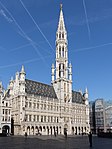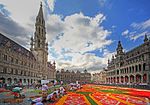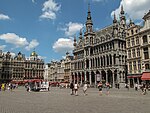Fashion & Lace Museum
1977 establishments in BelgiumBelgian building and structure stubsEuropean museum stubsFashion museumsMuseums established in 1977 ... and 2 more
Museums in BrusselsTextile arts of Belgium

The Fashion & Lace Museum (French: Musée Mode & Dentelle, Dutch: Mode & Kant Museum) is a textile and fashion museum in Brussels, Belgium. The museum collections focus on lace, which is a traditional craft in Belgium. It was founded in 1977.The museum has exhibitions of antique lace, the process of lacemaking, and also hosts temporary exhibits around historical and contemporary fashion. Antique lace exhibitions feature religious vestments and lace from Mechelen and Bruges. Additional exhibits include Barbie fashion and raincoats.
Excerpt from the Wikipedia article Fashion & Lace Museum (License: CC BY-SA 3.0, Authors, Images).Fashion & Lace Museum
Rue de la Violette - Violetstraat, City of Brussels Pentagon (Brussels)
Geographical coordinates (GPS) Address Nearby Places Show on map
Geographical coordinates (GPS)
| Latitude | Longitude |
|---|---|
| N 50.8458 ° | E 4.352 ° |
Address
Rue de la Violette - Violetstraat 12
1000 City of Brussels, Pentagon (Brussels)
Belgium
Open on Google Maps











